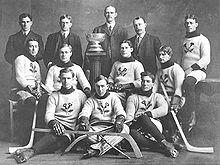Art Ross
He was on Stanley Cup championship teams twice in a playing career that lasted thirteen seasons; in January 1907 with the Kenora Thistles and 1908 with the Montreal Wanderers.
[a][c] His father, Thomas Barnston Ross, was of Scottish descent and originally from Chicoutimi, Quebec, while his mother was Marguerite (Margaret) McLeod.
Ross's parents initially lived in Lake St. John, Quebec (now Lac Saint-Jean), where Thomas worked for the Hudson's Bay Company (HBC).
[16] In January 1908, he participated in the first all-star game in sports history, a benefit for the family of former Wanderer defender Hod Stuart, who died the previous summer.
Ross received a cash bonus of $400 to play in a Stanley Cup challenge against a team from Edmonton in December 1908, in which the Wanderers won the two-game, total-goal series 13–10.
One of the teams, the All-Montreal Hockey Club, hired Ross as a playing manager, but the league only lasted until mid-January 1910 before disbanding.
During a match against the Quebec Bulldogs on February 25, 1911, Ross knocked out Eddie Oatman in a fight, provoking a massive brawl between the two teams, which the police had to break up.
As one of the top players on the team, the Wanderers agreed to his demands of $1,500 for the forthcoming season, in which he finished with four goals and nine points in eighteen games.
[23] The next season Ross, again concerned with his salary, began negotiating with other players in the NHA to leave their teams and form a new league that would offer higher wages.
[24] The proposed new league failed to materialize and Ross applied for reinstatement to the NHA, which was granted at a meeting of the team owners on December 18, 1914.
A two-game, total goal series was played to determine the NHA league champion who would contest the Stanley Cup with the Pacific Coast Hockey Association winner, the Vancouver Millionaires.
Termed "kitty bar the door", it required three defenders to align themselves across the ice 30 feet in front of the goaltender to stop offensive rushes.
[28] This style of defence would later be used in a modified version known as the neutral zone trap, later used widely to stop opposition offensive chances.
[29] The following year Ross, who had eight goals and eight assists in twenty-one games, was the second highest-paid player on the team; his salary of $1,400 was $100 less than Frank Nighbor made.
[30] The Wanderers, along with the Montreal Canadiens, Toronto Arenas, Quebec Bulldogs, and Ottawa Senators dissolved the NHA and founded the National Hockey League (NHL) in November 1917.
[34] Ross began his career as a hockey coach during his playing days when at age 25 he led the McGill University Redmen to a 4–2–1 record during the 1910–11 season.
[36] He was hired to coach the Hamilton Tigers for the 1922–23 season, and adopted new methods in training camp that emphasized physical fitness, including work off the ice.
[37] However, the Tigers finished with a record of six wins and eighteen losses, last in the NHL for the third successive year, and Ross did not return the next season.
[38] His next coaching appointment arose from meeting Boston grocery store magnate Charles Adams during the 1924 Stanley Cup Finals.
As a result, the Bruins acquired the rights to several future Hall of Fame players, the most notable being defender Eddie Shore.
[47] Ross acquired Cy Denneny from Ottawa and made him a player-assistant-coach while he assumed the role of coach and team manager.
From December 3, 1929, until January 9, 1930, the team won fourteen games in a row, a record that lasted until 1982 and now tied for the third longest, as of October 2010.
A home winning streak began the same day and lasted for twenty games, until March 18, 1930, which was tied for the longest of its kind in 1976.
[44] On March 26, 1931, Ross substituted a sixth skater for goaltender Tiny Thompson in the final minute of play in a playoff game against the Montreal Canadiens.
Although the Bruins lost the game 1–0, Ross became the first coach to replace his goaltender with an extra attacker, a tactic that became a widespread practice in hockey.
[52] By this time the Second World War had caused several Bruins players, including the entire Kraut Line and goaltender Brimsek, to enlist in their respective armed forces.
[13] A ceremony for his induction was held before a Bruins game on December 2, 1949, where he was given his Hall of Fame scroll and a silver tray with the emblems of the six NHL teams on it.
[60] Along with his two sons he donated the Art Ross Trophy to the NHL in 1947, to be awarded to the leading scorer in the league's regular season.
[22] After graduating from high school in 1903, Ross began working at Merchants Bank and occasionally played for their hockey team.
[64] In 1928, he served as the traveling secretary of the Boston Braves baseball team, which was owned by Bruins owner Charles Adams.



